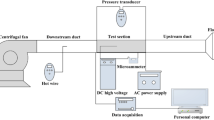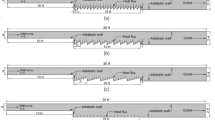Abstract
The hydraulic performance of fluid in a cross-corrugated channel has been investigated, numerically and experimentally, by a three-dimensional model with an exact geometry of the heat exchanger. The distributions of the fluid and local flow characteristics have been discussed, especially for the flow around the contact points in the developing and periodic fully developed sections. The velocity and pressure variations in different cross sections have also been presented. Experiments have been carried out to validate the numerical predictions. The friction factors between the numerical computation and the experimental data are in a reasonable agreement in the range of Reynolds number being equal to 660–2,000.











Similar content being viewed by others
Abbreviations
- A c :
-
Cross-section area of the cross-corrugated channel, m2
- b c :
-
Mean spacing between two plates, m
- C 2, C 1ε, C µ :
- D :
-
Inner diameter of the ports, m
- d c :
-
Hydraulic diameter of the channel, m
- f :
-
Friction factor
- G :
-
Flow rate, m3/s
- G k :
-
Generation of turbulence kinetic energy due to the mean velocity gradients
- G b :
-
Generation of turbulence kinetic energy due to the buoyancy
- k :
-
Turbulence kinetic energy, m2/s2
- L :
-
Plate length, m
- Re :
-
Reynolds number of the channel
- u c :
-
Velocity in the channel, m/s
- u j :
-
Velocity component in the (x, y, z) direction, m/s
- u p :
-
Velocity in the ports, m/s
- w :
-
Plate width, m
- x j :
-
Cartesian coordinates (x, y, z)
- ρ :
-
Fluid density, kg/m3
- ε :
-
Turbulence dissipation rate, m2/s3
- M :
-
Viscosity of working fluid, Pa s
- µ t :
-
Turbulent viscosity, Pa s
- ΔP :
-
Total pressure drop of the heat exchanger, Pa
- ΔP port :
-
Pressure drop at the inlet and outlet ports, Pa
- ΔP channel :
-
Pressure drop of the cross-corrugated channel, Pa
- ΔP ec :
-
Pressure drop due to sudden expansion and contraction, Pa
References
Martin H (1996) A theoretical approach to predict the performance of chevron-type plate heat exchangers. Chem Eng Process 35:301–310
Charre O, Jurkowski R, Bailly A, Meziani S, Altazin A (2002) General model for plate heat exchanger performance prediction. J Enhanc Heat Transf 9:181–186
Reinhard W, Ostrowski N (2004) Experimental investigations of heat transfer and pressure drop during the condensation process within plate heat exchangers of the herringbone-type. Int J Enhanc Therm Sci 43:59–68
Rao BP, Das SK (2004) An experimental study on the influence of flow maldistribution on the pressure drop across a plate heat exchanger. ASME J Fluid Eng 126:680–691
Focke WW, Knibbe PG (1986) Flow visualization in parallel-plate ducts with corrugated walls. J Fluid Mech 165:73–77
Focke WW, Zachariades J, Olivier I (1985) The effect of the corrugation inclination angle on the thermalhydraulic performance of plate heat exchangers. Int J Heat Mass Transf 28(8):1469–1479
Galeazzo FCC, Miura RY, Gut JAW, Tadini CC (2006) Experimental and numerical heat transfer in a plate heat exchanger. Chem Eng Sci 61:7133–7138
Jang JY, Lin CN (2000) A numerical analysis of three dimensional heat transfer and fluid flow in chevron plate channels. ASRAE Trans Symp 106:856–863
Kanaris AG, Mouza AA, Paras SV (2006) Flow and heat transfer prediction in a corrugation plate heat exchanger using a CFD code. Chem Eng Technol 29(8):923–930
SolidWorks (2007) http://www.solidworks.com/. Dassault Systèmes SolidWorks Corp., Concord, MA, USA
Fluent (2006) Fluent 6.2 User’s Manual, Fluent Inc., Lebanon, NH, USA
Acknowledgments
Financial support for this work is provided by the I-Shou University under the contract ISU99-02-24. The authors would like to thank the anonymous referees for their helpful and constructive comments and suggestions.
Author information
Authors and Affiliations
Corresponding author
Rights and permissions
About this article
Cite this article
Liu, FB., Tsai, YC. An experimental and numerical investigation of fluid flow in a cross-corrugated channel. Heat Mass Transfer 46, 585–593 (2010). https://doi.org/10.1007/s00231-010-0605-7
Received:
Accepted:
Published:
Issue Date:
DOI: https://doi.org/10.1007/s00231-010-0605-7




